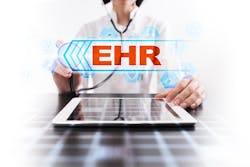Health systems are starting to see EHR optimization as central to their overall clinician wellness programs and efforts to alleviate burnout. Based on the success of their agile sprint team approach, UCHealth in Colorado has added a second 11-person sprint team in 2019, and 10 other academic medical centers are working to replicate their model.
In a recent talk to the UC Department of Medicine, Amber Sieja, M.D., senior medical director of informatics at UCHealth, described how they got started and some lessons learned as they iterated their approach.
Sieja, who directs the sprint program, said that national data from KLAS’ ARCH collaborative suggests that once a year providers and staff should get seven hours of EHR training. “From 2011 to 2018, we were really not doing any,” she said. “We were doing newsletters but not requiring anything. Now they ask for seven hours of provider and clinical staff time.
She stressed that the sprints are not just about efficiency of practice. “We work with clinicians and staff to discover and improve critical intersections between the EHR and clinical workflows to create a more satisfying provider, staff and patient experience,” she said. A sprint team is made up of a project manager, physician and nurse informaticians, trainers, and analysts.
In 2016 when they piloted their agile approach in endocrinology, clinicians there were suspicious of the approach, she said. The team uses “net promoter scores (NPS)” common in other sectors such as retail – basically asking how likely the clinicians are to recommend Epic. In that first clinic, the provider NPS went from negative 44 to zero in two weeks. However, in that clinic the staff burnout scores actually increased. “We realized we weren’t dedicating time to staff. If they had questions, we answered them. But the solution is now we sprint the whole clinic now – case managers, social workers, front-desk folks. We went in with a practice efficiency mindset. We were teaching EHR tools and that was it. We started putting more emphasis on teamwork and the right processes and not just the tools. After taking that approach with six or seven clinics, they found that teamwork metrics doubled after a two-week sprint.”
The sprint team starts working with a clinic 90 to 120 days before the two-week sprint to block out physician schedules and determine who is going to be physician leads and who else in the clinic should be involved in leadership roles. “We make sure we have the right people on huddles and e-mails,” she said, and do surveys right before and after the sprint. We do have a core curriculum. If they have questions, we set it aside and answer those first, then come back to the curriculum. We have to go back and forth between what is the structure that works well and where we can flex to get and keep their attention.”
They teach chart review, inbasket, notes and orders. “We also get a lot of interest in setting up Dragon, Haiku, secure chat, and verbal chart search,” she said.
Presenting some aggregate data, she said clinicians rating the EHR went from a pre-sprint net promoter score of 10 to a post-sprint score of 47. For staff, the rating went from 24 to 46. The NPS for the sprint itself was 62 for providers and 65 for staff.
Responding to the statement, “Our clinic has clear policies on how staff and providers can best use the Epic EHR together,” pre-sprint, 36 percent of providers said yes; one month post-sprint, that number was 72 percent.
Importantly, the data suggests that sprints decrease burnout. A survey question “I feel burned out from my work,” had positive responses from 39 percent pre-sprint and 34 percent post-sprint. “We also have started asking about not just burnout but also about wellness — thriving and core emotional recovery. The numbers are improving and moving in right direction.”
They added a second sprint team in 2019 because they realized that with one team they would never reach all the clinics in the system within a few years. (UCHealth has grown to include 12 hospitals and hundreds of clinics in Colorado, Wyoming and Nebraska.)
Sieja closed by saying research found that clinicians are saving about 16 minutes per day after sprints. “But if we are just looking at time savings, we may or may not be successful,” she added. “But we are looking at culture and the joy of practice — and how they perceive the EHR is not just about how much time they spend on it.”


